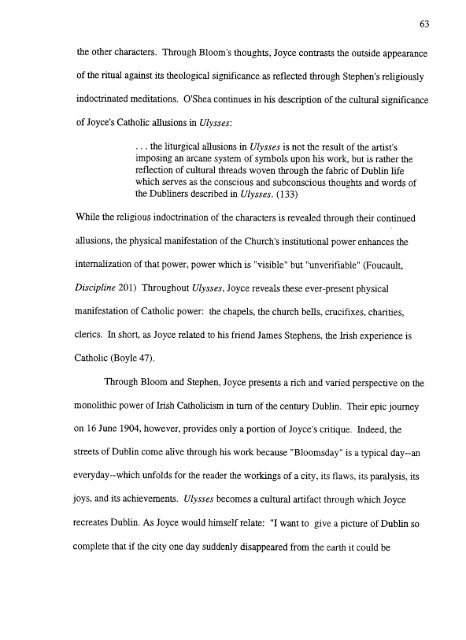Faubourg Saint Patrice - ScholarsArchive at Oregon State University
Faubourg Saint Patrice - ScholarsArchive at Oregon State University
Faubourg Saint Patrice - ScholarsArchive at Oregon State University
You also want an ePaper? Increase the reach of your titles
YUMPU automatically turns print PDFs into web optimized ePapers that Google loves.
the other characters. Through Bloom's thoughts, Joyce contrasts the outside appearance<br />
of the ritual against its theological significance as reflected through Stephen's religiously<br />
indoctrin<strong>at</strong>ed medit<strong>at</strong>ions. O'Shea continues in his description of the cultural significance<br />
of Joyce's C<strong>at</strong>holic allusions in Ulysses:<br />
. . . the liturgical allusions in Ulysses is not the result of the artist's<br />
imposing an arcane system of symbols upon his work, but is r<strong>at</strong>her the<br />
reflection of cultural threads woven through the fabric of Dublin life<br />
which serves as the conscious and subconscious thoughts and words of<br />
the Dubliners described in Ulysses. (133)<br />
While the religious indoctrin<strong>at</strong>ion of the characters is revealed through their continued<br />
allusions, the physical manifest<strong>at</strong>ion of the Church's institutional power enhances the<br />
internaliz<strong>at</strong>ion of th<strong>at</strong> power, power which is "visible" but "unverifiable" (Foucault,<br />
Discipline 201) Throughout Ulysses, Joyce reveals these ever-present physical<br />
manifest<strong>at</strong>ion of C<strong>at</strong>holic power: the chapels, the church bells, crucifixes, charities,<br />
clerics. In short, as Joyce rel<strong>at</strong>ed to his friend James Stephens, the Irish experience is<br />
C<strong>at</strong>holic (Boyle 47).<br />
Through Bloom and Stephen, Joyce presents a rich and varied perspective on the<br />
monolithic power of Irish C<strong>at</strong>holicism in turn of the century Dublin. Their epic journey<br />
on 16 June 1904, however, provides only a portion of Joyce's critique. Indeed, the<br />
streets of Dublin come alive through his work because "Bloomsday" is a typical day--an<br />
everyday--which unfolds for the reader the workings of a city, its flaws, its paralysis, its<br />
joys, and its achievements. Ulysses becomes a cultural artifact through which Joyce<br />
recre<strong>at</strong>es Dublin. As Joyce would himself rel<strong>at</strong>e: "I want to give a picture of Dublin so<br />
complete th<strong>at</strong> if the city one day suddenly disappeared from the earth it could be<br />
63















